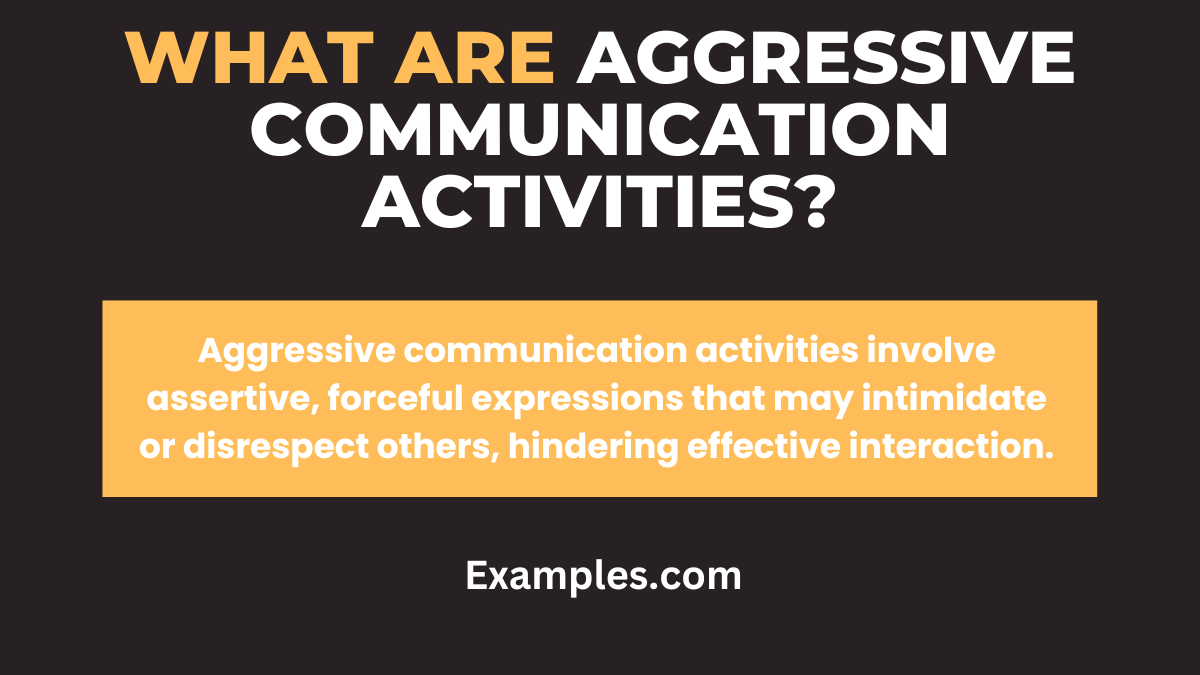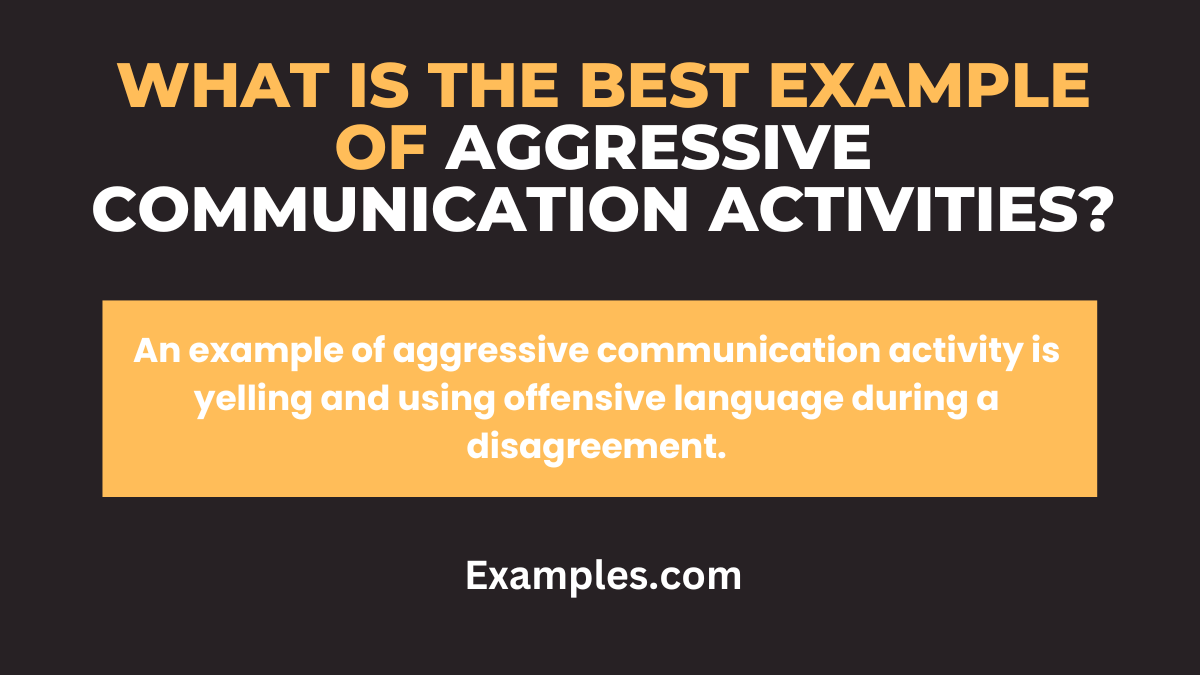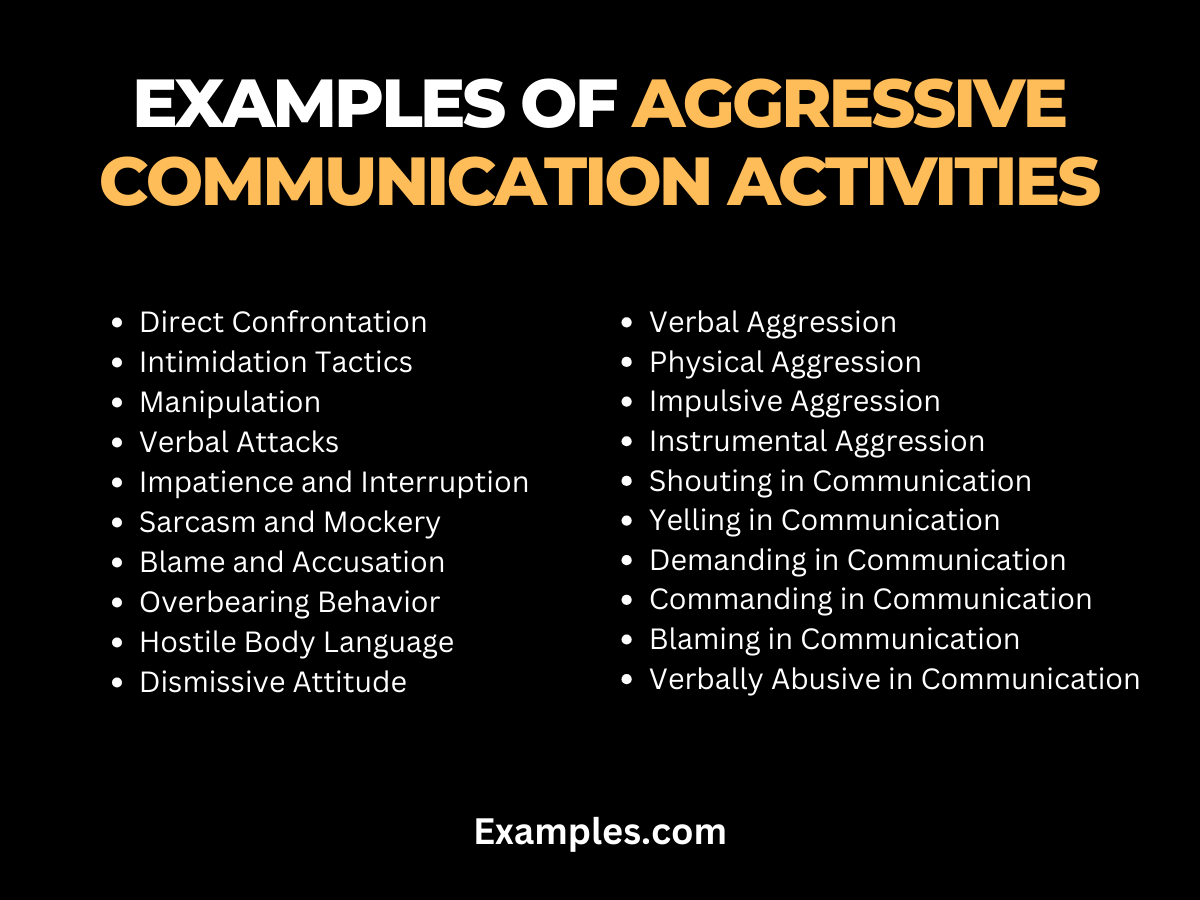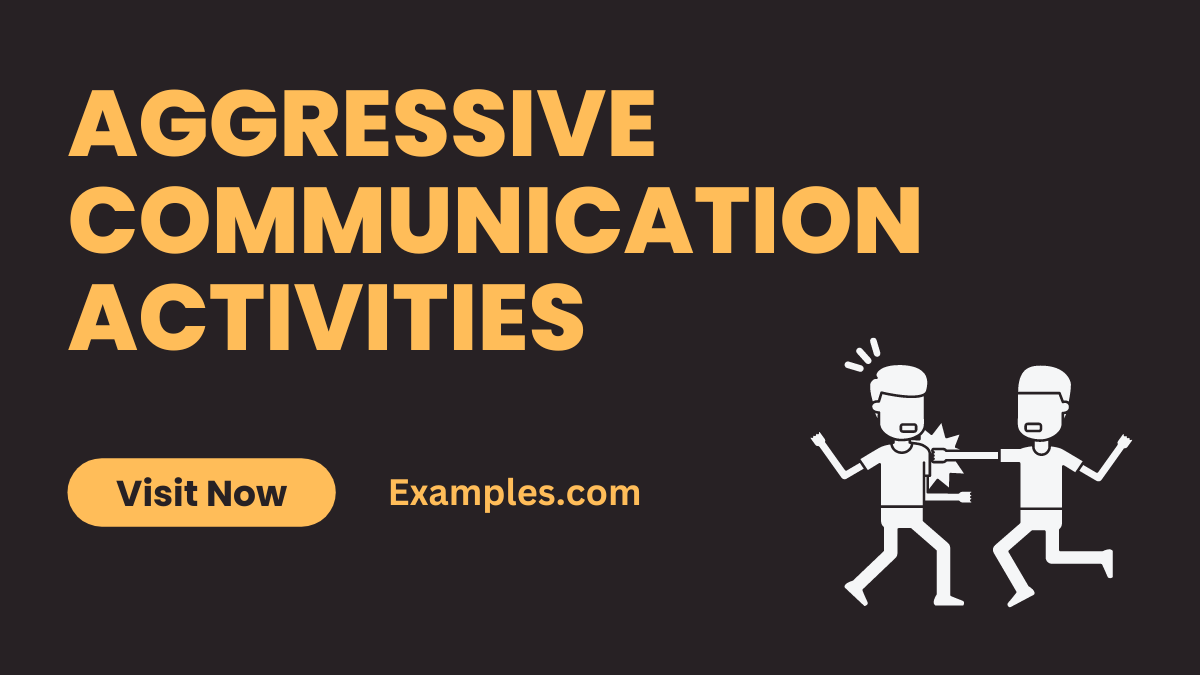19+ Aggressive Communication Activities Examples
Aggressive Communication Activities encompass a range of behaviors and styles often perceived as forceful or confrontational. This guide delves into the nature of such communication, exploring its various forms, underlying characteristics, and the thin line separating assertiveness from aggression. We aim to provide a comprehensive understanding of aggressive communication, its potential impacts, and how it can be navigated in personal and professional contexts. The guide will also offer insights into transforming aggressive communication into more effective and empathetic interactions.
What are Aggressive Communication Activities?

Aggressive Communication Activities involve interactions where one party adopts a dominating, forceful, or confrontational approach. This can manifest in various forms, from verbal outbursts to non-verbal cues, often leading to negative consequences in interpersonal relationships.
What is the Best Example of Aggressive Communication Activities?

One of the most quintessential examples includes a manager reprimanding an employee in a demeaning tone, using accusatory language and dismissive body language, reflecting a classic case of workplace aggression.
20 Examples of Aggressive Communication Activities

Aggressive communication is a direct and forceful style, often leading to strained relationships and misunderstandings. It involves behaviors like intimidation, sarcasm, and verbal attacks, which can be detrimental in various settings, including the workplace and personal interactions. This article delves into 20 aggressive communication activities, highlighting the characteristics and impacts of such behaviors, along with the types of aggressive communication like verbal and physical aggression. Each example is paired with explanations and example sentences, offering insight into the aggressive communication spectrum.
1. Direct Confrontation: This involves openly challenging someone’s ideas or opinions, often in a public setting like a meeting. It can create a hostile environment and discourage open communication.
- Example: “Your idea is completely flawed and won’t work.”
2. Intimidation Tactics: These tactics use physical presence or tone to instill fear or submission in others. It’s a form of bullying and can severely damage workplace relationships and morale.
- Example: “Do it my way, or else.”
3. Manipulation: This involves twisting words or situations to gain control or advantage, often at the expense of others’ feelings or interests. It can erode trust and lead to resentment.
- Example: “You would do this if you really cared about the team.”
4. Verbal Attacks: This form of aggression includes insulting or belittling someone during a conversation. It is damaging to the recipient’s self-esteem and can lead to a toxic communication environment.
- Example: “You’re clueless about this topic.”
5. Impatience and Interruption: Characterized by constantly cutting off others while they are speaking. This behavior shows a lack of respect for others’ opinions and can stifle collaborative discussions.
- Example: “Stop talking; I know better.”
6. Sarcasm and Mockery: Using sarcastic comments or mocking to demean others. It often creates a negative and hostile atmosphere in interactions.
- Example: “Oh, like you’re the expert now!”
7. Blame and Accusation: This involves pointing fingers at others without taking personal responsibility. It can lead to a culture of defensiveness and mistrust.
- Example: “This is all your fault, as usual.”
8. Overbearing Behavior: Dominating conversations and decisions, often disregarding others’ input. This can stifle creativity and collaboration in a team.
- Example: “Just do as I say, I’m in charge here.”
9. Hostile Body Language: Using aggressive gestures, like leaning in too close or pointing fingers, to intimidate or express dominance.
- Example: Leaning in too close, pointing fingers.
10. Dismissive Attitude: This behavior includes ignoring or trivializing others’ opinions, making them feel undervalued and disrespected.
- Example: “Your opinion doesn’t matter here.”
11. Verbal Aggression: This form of aggression involves using harsh words to express anger or frustration. It can lead to a harmful and unproductive communication environment.
- Example: “You always mess things up!”

12. Physical Aggression: Using physical actions to intimidate or harm. This behavior can create a threatening environment and is unacceptable in any setting.
- Example: Slamming doors or throwing objects.
13. Impulsive Aggression: Characterized by reacting violently without thinking. Such outbursts can be unpredictable and damaging to relationships.
- Example: “Lashing out unexpectedly in anger.”
14. Instrumental Aggression: This involves using aggression strategically to achieve a specific goal, often disregarding the well-being of others.
- Example: “Bullying someone to get what you want.”
15. Shouting in Communication: Raising your voice to overpower or intimidate others. It can shut down meaningful dialogue and create fear.
- Example: “I won’t repeat myself, do it now!”
16. Yelling in Communication: Involves screaming to express dominance or control. It’s an extreme form of communication that can be very distressing.
- Example: “I’m the boss here, listen to me!”
17. Demanding in Communication: Insisting on immediate compliance or action in a forceful manner. This can lead to resentment and a lack of cooperation.
- Example: “I need this done now, no excuses.”
18. Commanding in Communication: Giving orders without room for discussion or input. It’s authoritative and often disregards others’ perspectives.
- Example: “Do this task, I won’t take no for an answer.”
19. Blaming in Communication: Involves assigning fault to others for problems or issues. It avoids accountability and can create a culture of finger-pointing.
- Example: “It’s your fault we’re in this mess.”
20. Being Verbally Abusive in Communication: This includes using demeaning or degrading language to belittle or intimidate someone. It’s harmful and creates a toxic environment.
- Example: “You’re useless and a waste of space in this team.”
How to Improve Aggressive Communication Activities
Improving aggressive communication involves transforming it into a more constructive form. Here are five key points:
- Recognize Aggressive Tendencies: Identify moments when your communication turns aggressive, like raising your voice or interrupting others.
- Practice Active Listening: Focus on understanding the other person’s point of view without immediately responding or reacting.
- Develop Empathy: Try to understand the feelings and perspectives of others to communicate more compassionately.
- Use “I” Statements: Express your feelings and needs without blaming or accusing others, e.g., “I feel upset when…”
- Seek Feedback: Regularly ask for feedback on your communication style and be open to making adjustments.
Aggressive Communication Activities for Students
For students, aggressive communication can hinder learning and relationships. Here are five points to address this:
- Role-Playing Exercises: Engage in scenarios that teach how to express opinions assertively, not aggressively.
- Conflict Resolution Workshops: Participate in workshops to learn peaceful resolution of disputes.
- Communication Skills Classes: Attend classes that focus on effective and respectful communication strategies.
- Peer Mediation Programs: Get involved in peer mediation to understand diverse perspectives and resolve conflicts amicably.
- Mindfulness and Stress Management: Practice mindfulness and stress management techniques to control impulsive reactions.
Aggressive Communication Activities is essential for effective interpersonal communication. This article has provided valuable insights and practical guidance on recognizing, addressing, and improving aggressive communication behaviors. By applying the tips and techniques discussed, individuals can foster healthier relationships, resolve conflicts, and promote constructive dialogue, leading to more positive and productive interactions in personal and professional settings.



